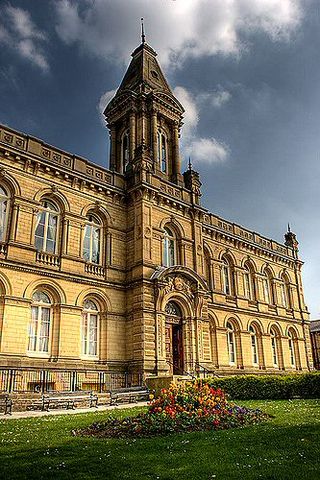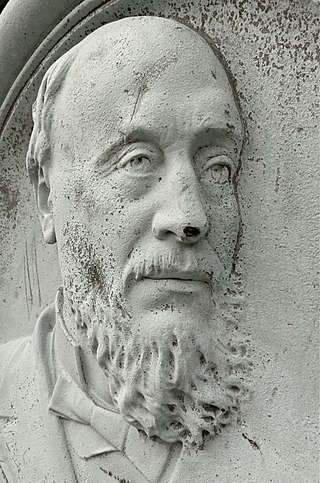
Sir Titus Salt, 1st Baronet, was a manufacturer, politician and philanthropist in Bradford, West Riding of Yorkshire, England, who is best known for having built Salt's Mill, a large textile mill, together with the attached village of Saltaire, West Yorkshire.

Saltaire is a Victorian model village in Shipley, West Yorkshire, England, situated between the River Aire, the railway, and the Leeds and Liverpool Canal. Salt's Mill and the houses were built by Titus Salt between 1851 and 1871 to allow his workers to live in better conditions than the slums of Bradford. The mill ceased production in 1986, and was converted into a multifunctional location with an art gallery, restaurants, and the headquarters of a technology company. It is a UNESCO World Heritage Site and on the European Route of Industrial Heritage.

Shipley is a historic market town and civil parish in the City of Bradford, West Yorkshire, England, by the River Aire and the Leeds and Liverpool Canal, north of Bradford. The population of the Shipley ward on Bradford City Council taken at the 2011 Census was 15,483.

Baildon is a town and civil parish in the Bradford Metropolitan Borough in West Yorkshire, England and within the historic boundaries of the West Riding of Yorkshire.

Bradford, commonly called the City of Bradford, is a local government district of West Yorkshire, England, with the status of a city and metropolitan borough. It is named after its largest settlement, Bradford, but covers a large area which includes the towns and villages of Keighley, Shipley, Bingley, Ilkley, Haworth, Silsden, Queensbury, Thornton and Denholme. Bradford has a population of 528,155, making it the fourth-most populous metropolitan district and the sixth-most populous local authority district in England. It forms part of the West Yorkshire Urban Area conurbation which in 2011 had a population of 1,777,934, and the city is part of the Leeds-Bradford Larger Urban Zone (LUZ), which, with a population of 2,393,300, is the fourth largest in the United Kingdom after London, Birmingham and Manchester.

A model village is a type of mostly self-contained community, built from the late 18th century onwards by landowners and business magnates to house their workers. Although the villages are located close to the workplace, they are generally physically separated from them and often consist of relatively high-quality housing, with integrated community amenities and attractive physical environments. "Model" is used in the sense of an ideal to which other developments could aspire.
Salt is a dietary mineral, used for flavoring and preservation.

Lister Mills was the largest silk factory in the world. It is located in the Manningham district of Bradford, West Yorkshire, England and was built by Samuel Cunliffe Lister to replace the original Manningham Mills which had been destroyed by fire in 1871. The mill is a Grade II* listed building, built in the Italianate style of Victorian architecture.

Bradford is a city in West Yorkshire, England. It is governed by a metropolitan borough named after the city, the wider county has devolved powers. It had a population of 349,561 at the 2011 census; the second-largest subdivision of the West Yorkshire Built-up Area after Leeds, which is approximately 9 miles (14 km) to the east. The borough had a population of 546,412, making it the 7th most populous district in England.

Henry Francis Lockwood was an influential English architect active in the North of England.
Jonathan Silver (1949–1997) was an entrepreneur from Bradford, Yorkshire, who was responsible for restoring Salts Mill as a thriving cultural, retail and commercial centre.

Roberts Park is a 14 acres (5.7 ha) public urban park in Saltaire, West Yorkshire, England. Higher Coach Road, Baildon, is to the north and the park is bounded to the south by the River Aire. A pedestrian footbridge crosses the Aire and links the park to the village of Saltaire. The park is an integral part of the Saltaire World Heritage site.
The following is a timeline of the history of the city of Bradford, West Yorkshire, England.

Victoria Hall, Saltaire is a Grade II* listed building in the village of Saltaire, near Bradford, West Yorkshire, England, built by architects Lockwood and Mawson.

Saltaire United Reformed Church is a church at Saltaire, West Yorkshire, England. Commissioned and paid for by Titus Salt in the mid 19th century, the church is a Grade I listed building and sits within the Saltaire World Heritage Site.

William Mawson was an English architect best known for his work in and around Bradford.

Drummond Mill was a complex of industrial buildings on Lumb Lane, Manningham, Bradford, West Yorkshire. It contained originally a spinning mill, a warehouse, a spinning shed, and an engine house with chimney and was destroyed in a fire on 28 January 2016.
Saltaire is a model village in Shipley, a ward in the metropolitan borough of the City of Bradford, West Yorkshire, England. The village contains 93 listed buildings that are recorded in the National Heritage List for England. Of these, one is listed at Grade I, the highest of the three grades, four are at Grade II*, the middle grade, and the others are at Grade II, the lowest grade. In 1850 Titus Salt started to build a textile mill, known as Salt's Mill, alongside the Leeds and Liverpool Canal and then developed the model village to house and serve its workers. This included housing, shops, and community buildings, all of which are listed. The architects for the entire scheme, including later mills, were the Bradford architects Lockwood and Mawson. All the listed buildings built between 1850 and 1870 were designed by them. The later listed buildings are a tram shed, a war memorial and a telephone kiosk.
Shipley is a ward in the metropolitan borough of the City of Bradford, West Yorkshire, England. Excluding the listed buildings in the model village of Saltaire, which are the subject of a separate list, it contains 14 listed buildings that are recorded in the National Heritage List for England. Of these, one is at Grade II*, the middle of the three grades, and the others are at Grade II, the lowest grade. The listed buildings consist of a farmhouse and a barn, houses, churches and associated structures, a canal bridge and a warehouse, mill buildings, including a chimney, and a war memorial.

Milner Field was a large country house near Saltaire in West Yorkshire, England built in 1872 for Titus Salt Junior, youngest son of the Yorkshire wool merchant and philanthropist Sir Titus Salt and demolished in the 1950s. The house was situated at the edge of the village of Gilstead, near Bingley, overlooking the Aire Valley in the direction of Salt senior's model village of Saltaire and Salts Mill.















